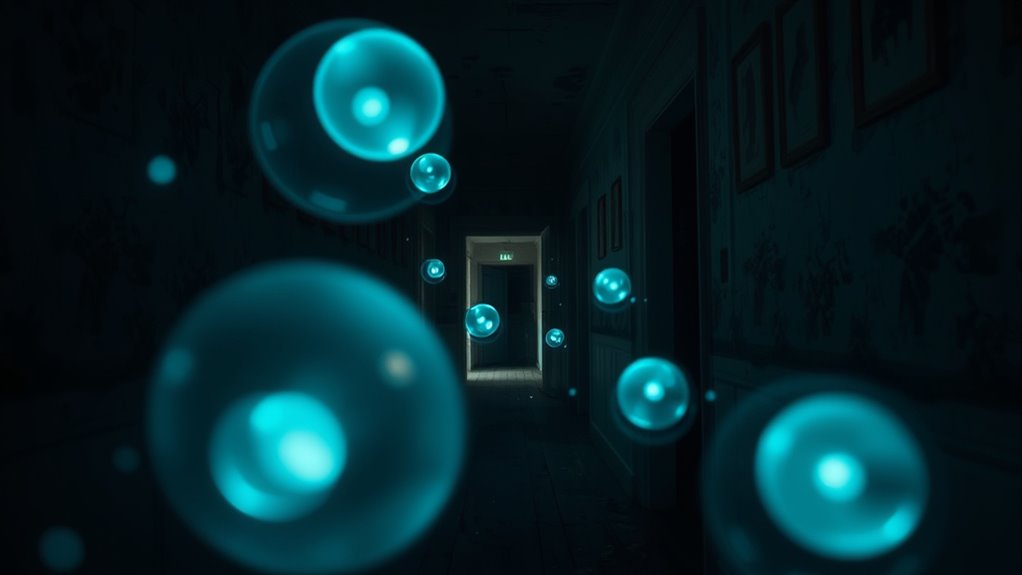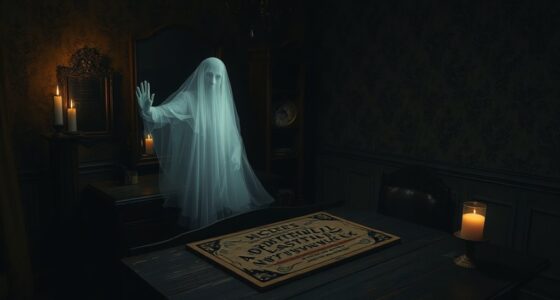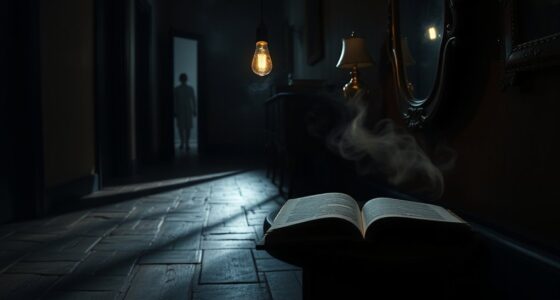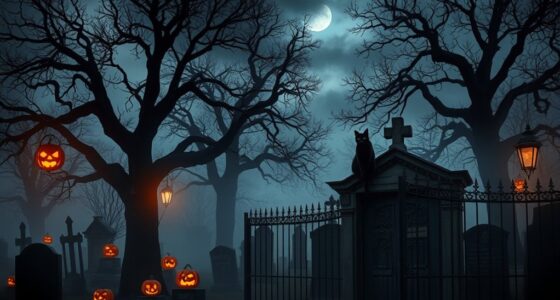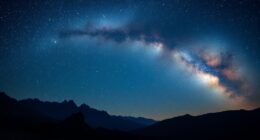Orbs captured in photos or videos are not reliable evidence of ghosts, as most are caused by camera artifacts like dust, moisture, and reflections rather than supernatural phenomena. These glowing circles often appear when tiny particles reflect light or create lens flare, especially with modern cameras or poor lighting. While some believe orbs indicate spirits, scientific explanations suggest they’re simply natural effects. To learn more about what these mysterious images really mean, there’s much more to explore.
Key Takeaways
- Orbs are commonly caused by camera artifacts like dust, moisture, or reflections, not necessarily spirits.
- Their appearance often results from particles close to the lens illuminated by light or flash.
- While some believe orbs indicate paranormal activity, they lack conclusive scientific proof of ghosts.
- Many orb images are explained as natural phenomena or camera effects, not supernatural evidence.
- Additional contextual evidence is essential; orbs alone are insufficient to confirm ghost presence.
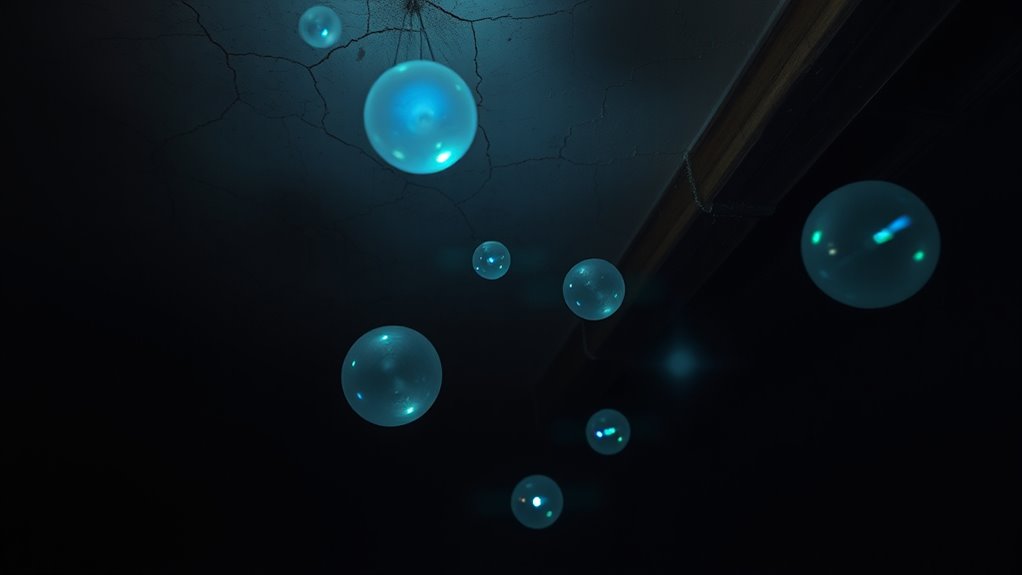
Many people believe that orbs captured in photographs or videos are proof of ghosts, but the reality is more complicated. When you explore the world of paranormal research, you’ll find that orbs are often misunderstood. Paranormal investigators frequently analyze these glowing circles, trying to determine if they’re supernatural phenomena or just artifacts created by camera technology. Advances in camera technology have made it easier to capture images in low-light conditions, but they also increase the likelihood of capturing false positives—images that look mysterious but have simple explanations.
In your investigation of orbs, you’ll learn that most of these orbs are caused by dust, pollen, or moisture particles close to the camera lens. When a camera’s flash or bright light hits these tiny particles, they reflect back, creating the appearance of glowing orbs. This effect is especially common in indoor environments or areas with poor air quality, where dust and moisture are prevalent. Many skeptics argue that these are nothing more than camera artifacts, not evidence of spirits or supernatural activity.
Understanding how camera technology works can help you identify these false positives. Modern digital cameras and smartphone cameras often have a short exposure time, which can cause reflections or lens flare to appear as orbs. Additionally, the use of flash can illuminate particles right in front of the lens, making them more prominent in the image. If you want to avoid misinterpreting these images, paying attention to the conditions when you take photos is key. Take multiple shots without flash, or move around to see if the orb persists. If the orb appears only in certain conditions, it’s likely a camera artifact rather than a paranormal entity.
Paranormal research often involves analyzing the context and consistency of orb sightings, but even then, conclusions are tricky. Many researchers acknowledge that while orbs can sometimes be associated with paranormal activity, they’re far from definitive proof. Often, they’re just natural phenomena or camera quirks. If you’re genuinely curious about whether orbs are evidence of ghosts, you’ll need to consider the broader context, including other signs of paranormal activity, rather than relying solely on orb images.
Additionally, some researchers suggest that orbs might sometimes be energy manifestations, although scientific evidence for this remains inconclusive. In the end, understanding the role of camera technology helps you approach orb images with a healthy dose of skepticism. Recognizing how dust, moisture, and light reflections influence what you see in photos empowers you to distinguish between natural causes and potential supernatural signals. While the mystery of orbs remains a popular topic in paranormal research, it’s essential to stay grounded in scientific explanations before jumping to supernatural conclusions.
Frequently Asked Questions
Can Orbs Be Caused by Natural Environmental Factors?
Yes, orbs can be caused by natural environmental factors. You might notice orbs due to lighting conditions, like camera flashes or reflections, which create bright spots. Dust particles in the air also contribute, as they reflect light and appear as orbs in photos or videos. These natural elements often explain orbs, making them less likely to be evidence of paranormal activity. Always consider environmental factors before jumping to conclusions.
Are There Specific Camera Settings That Influence Orb Appearance?
Like in the days of dial-up internet, your camera settings can considerably affect orb appearance. Using a wide aperture, high ISO, or slow shutter speed can increase the likelihood of capturing dust particles or lens flare, which look like orbs. To reduce this, adjust your focus, clean your lens, and experiment with different settings such as lower ISO and faster shutter speeds. These tweaks help minimize unwanted orb-like artifacts.
How Can I Distinguish Between Real Orbs and Camera Artifacts?
To distinguish between real orbs and camera artifacts, pay attention to lighting conditions and lens quality. Real orbs often appear in low-light settings with consistent shapes and movement, while artifacts tend to flicker or appear randomly due to lens flare or dust. Use a high-quality lens and avoid bright reflections. If an orb remains stationary in multiple shots under different lighting, it’s more likely to be genuine.
Do Orbs Appear Consistently in the Same Locations?
Orbs don’t usually appear consistently in the same locations, as lighting artifacts and camera glitches often cause them to shift or appear randomly. If you notice orbs repeatedly in the same spot, it’s likely due to reflections, dust, or moisture rather than paranormal activity. To differentiate, check for lighting artifacts caused by light sources and camera glitches that can create false orbs, and look for patterns or changes over multiple shots.
What Scientific Explanations Exist for Orb Phenomena?
Scientific explanations for orb phenomena include photography illusions caused by camera flash reflections or dust, pollen, and insects close to the lens. Atmospheric disturbances like humidity, mist, or light reflections also create orb-like images. These natural effects often mimic ghostly orbs, leading to misconceptions. So, what you see as orbs may just be optical phenomena rather than supernatural evidence, making it essential to analyze the conditions and equipment involved.
Conclusion
So, when you see orbs in your photos, remember they might just be dust or moisture, not spirits. While it’s tempting to believe they’re ghosts, science suggests otherwise. But isn’t it exciting to think that some mysteries might still be out there? Whether or not orbs are proof of ghosts, they remind us of life’s unexplained wonders. Keep your mind open, and let curiosity lead your quest for the truth.
